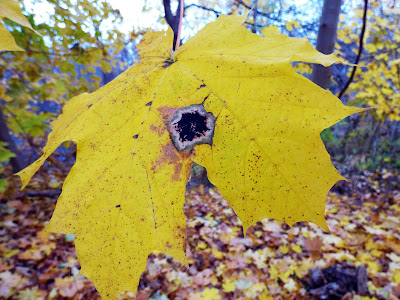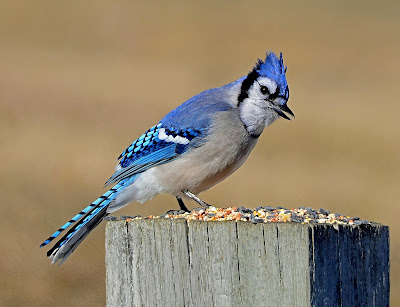Nature News: Tar spot fungus showing up on maple leaves
 |
| Tar spot on sugar maple leaf photo by Sue Pike |
There are mushrooms and then there are fungi, essentially the same thing (mushrooms are the reproductive parts of fungi), but while we humans think mushrooms are cute and give them fanciful names like toadstools or pixie rings, a large number of fungi go unnoticed or unrecognized. Or even worse (if you are a fungi who takes umbrage at human misunderstandings) many fungi are considered to be diseases. Athlete’s foot for example - a fungi just trying to survive on human feet. Or the tar spot fungus that is showing up on many of the brilliant yellow maple leaves this fall.
Most of the sugar maple leaves in my neighborhood are dotted with these tar spots; my neighbors were wondering just how concerned they should be by this.
According to the Cornell University Plant Disease Diagnostic Clinic: “Several different fungi in the genus Rhytisma infect the leaves of maples and cause raised, black spots to form on upper leaf surfaces. The diseases are called 'tar spots' because their appearance so closely resemble droplets of tar on leaf surfaces. Tar spot alone is rarely serious enough to threaten the health of trees, but sometimes there can be so many spots that the tree becomes unsightly. Heavy infections can also cause early leaf drop -- a circumstance that causes the greatest consternation to homeowners because lawns are littered and must be raked before autumn officially arrives.” Yikes! It’s well past the arrival of autumn and I’m just getting around to raking my lawn; and while out there, rake in hand, I too noticed a large number of black-spotted maple leaves.
These black tar spots dotting my neighborhood leaves are the immature fruiting bodies of the Rhytisma fungus. These fruiting bodies are the spore-producing part of a fungus, what we usually call a mushroom or toadstool. When you see a mushroom on your lawn or sticking out of a tree you are seeing the reproductive part of a much larger fungal body — hidden below ground or in the tree.
The fungi that make these tar spots are examples of a type of fungus that makes its home within plants (these are called endophytes; “endo” meaning “within” and “-phyte” meaning “plant”). Tar spot likes to live in maple and sycamore leaves. It starts out as an unnoticeable light spot on the leaf in the spring, which gradually turns black and tar-like in the fall. These black spots are mats of fungal tissue (mycelium) protecting the immature reproductive structures (fruiting bodies) of the fungus. These spots overwinter on the leaves that fall to the ground. In the spring the fruiting bodies mature and shoot needle-like spores into the air that are carried by wind currents or animals up to the newly-unfolding leaves of host trees. The spores then penetrate the young leaves and start growing new tar spots.
If your maples are healthy they can coexist quite nicely with the tar spot fungi. If you really don’t like the look of the tar spots, the best way to discourage them is to rake up and dispose of the infected leaves when they fall. I personally don’t think you should ever use fungicides to control tar spot (a strategy suggested by some plant disease control companies) — fungi are just too important to ecosystem (and our) health to apply a fungicide that kills all sorts of beneficial fungi along with the hapless tar spot.
Instead of trying to control tar spot, how about thinking of it as just one more interesting fungi that lives in your backyard. Enjoy them - along with brilliant foliage and early frosts - tar spots are one more sign that fall is here.



Comments
Post a Comment